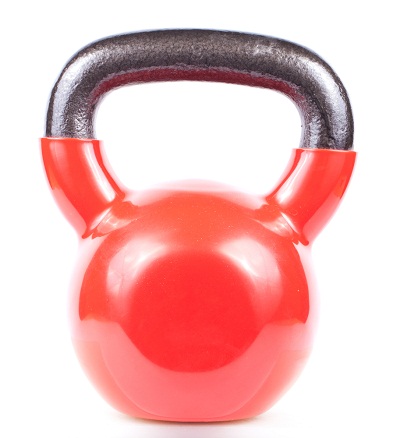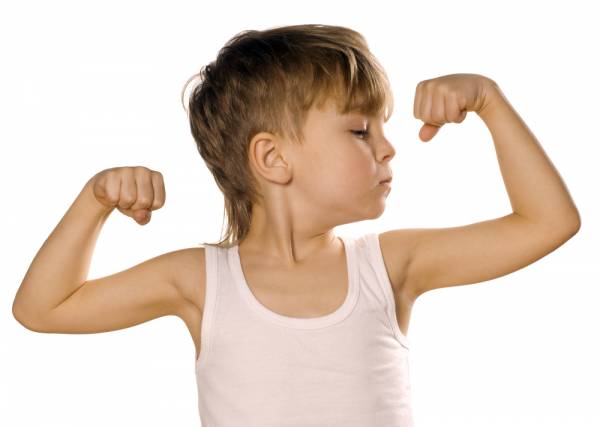In 2001 the American Academy of Pediatrics (AAP) revised its policy regarding children and strength training. Although the new policy discourages competitive weightlifting and bodybuilding in children,it also states, “…strength training programs may be undertaken to improve sports performance, rehabilitate injuries, prevent injuries, and/or enhance long-term health.” The new policy also makes it clear strength training during childhood does not stunt growth or contribute to increased risk of high blood pressure or decreased cardiovascular health.
I was relieved to learn about this policy and the supporting evidence. My three-year-old daughter is fascinated every time my husband or I do any kind of strength training and is always trying to join in. Although I don’t let her do any heavy lifting, I admit I do let her pick up a three-pounder every now and then. In fact, her strength and prowess have led her to refer to herself as the “warrior princess.” So I was glad to hear the experts agree strength training is safe and beneficial for little ones.
Of particular interest to me were the Academy’s guidelines for pediatrician evaluation of strength-training programs. One of these considerations is that, “a general strengthening program should address all major muscle groups and exercise through the complete range of motion.” When I read this, I immediately thought of kettlebells, which definitely fulfill this criterion for adults. As a parent though, I wondered: are kettlebells safe and effective for kids? Although they’ve certainly gained in popularity in recent years for adult use, are they also safe and effective for children?
The CrossFit Kids program is one example of a successful childrens’ program that utilizes kettlebells. Tiffany Divelbiss, Program Director of CrossFit Scottsdale Kids in Scottsdale, Arizona, emphasizes that kettlebells are ideal for a variety of age groups and experience levels:
Our kids program starts at three-years-old, and we have used the five-pound kettlebells with this age group to practice picking things up and putting them down and walking with them, training form, balance, stability, and strength…We continue using kettlebells throughout our program and for older age groups, utilizing kettlebell swings to reinforce and create power though the core and hips, supporting many movements needed in sports and continuing to support training the full body.
This description of the use of kettlebells sums up what to my mind are the three primary benefits of kettlebells for kids:
1. Kettlebells provide a dynamic workout.
 As noted by Nathan Donahue of Kettlebell Planet, “a barbell on the back of an undeveloped child is an accident waiting to happen. All they have to do is bend over with that bar loading their weak spine and an injury can happen.”Working out with kettlebells, on the other hand, encourages dynamic rather than static movements. Kettlebell swings are a perfect example of this dynamic potential.
As noted by Nathan Donahue of Kettlebell Planet, “a barbell on the back of an undeveloped child is an accident waiting to happen. All they have to do is bend over with that bar loading their weak spine and an injury can happen.”Working out with kettlebells, on the other hand, encourages dynamic rather than static movements. Kettlebell swings are a perfect example of this dynamic potential.
Of course, that’s not to say a dynamic workout is necessarily a safe workout. As with any other strength training program be sure your child knows how to perform kettlebell swings and other dynamic exercises properly. For example, emphasize that the swing isn’t simply executed by the arm, but rather that it’s supposed to be driven by the muscles in the legs, hips, back, and glutes.
2. Kettlebells work multiple muscle groups at once.
As noted by the American Council on Exercise, “Kettlebells require an individual to focus on whole-body conditioning because lifting and controlling a kettlebell forces the entire body, particularly the core, to contract as a group, simultaneously developing strength and stability.” The kettlebell’s ability to work multiple muscle groups at once means that it improves endurance as well as strength.
3. Kettlebell movements like swings and windmills also mimic everyday movements, making them functional tools.
As noted by Divelbiss, “In both life and sports, kids need to have a good foundation of strength overall to not only succeed but to prevent injury. The kettlebell is great for all this because it’s shape is conducive to being used by kids (they like the handle) and can be light or heavy but still maintain a relative size that is small and contained.”
Of course, this ties in with the dynamic quality of a kettlebell workout. Most kids aren’t training to get big biceps – or if they are, they shouldn’t be. During childhood, the primary purpose of strength training is to increase overall strength and condition of the body, which is why the AAP also recommends children incorporate regular aerobic exercise into their routine, in addition to strength training.
B eyond their physiological benefits, kettlebells provide many other advantages for children. Michelle Kilikauskas describes how kettlebell training helped her special needs daughter manage her weight and improve overall health. Because you can get an excellent whole-body workout in just thirty minutes or less, kettlebell training is also ideal for special needs kids with conditions that affect focus and concentration.
eyond their physiological benefits, kettlebells provide many other advantages for children. Michelle Kilikauskas describes how kettlebell training helped her special needs daughter manage her weight and improve overall health. Because you can get an excellent whole-body workout in just thirty minutes or less, kettlebell training is also ideal for special needs kids with conditions that affect focus and concentration.
Of course, safety is key with strength training at any age. “Our rule at CrossFit Scottsdale Kids is that none of the equipment is to be used without a coach’s permission and supervision….We always focus on proper form before increasing weight and have coaches to supervise movements. That being said, kids naturally are going to lift things inside and outside of the house, and because the kettlebell has a handle it is easy for kids to lift and is relatively safe,” says Divelbiss.
Kettlebells aren’t only functional and effective, but they’re also a ton of fun (no pun intended). As Divelbiss states, “By using kettlebells in our program we can teach and reinforce form on lifting weights and build strength throughout the entire body with a few movements. The kids are always excited to use them, which makes exercise fun too.” And every smart parent knows that a fun, safe, and effective workout is always a plus for kids (and parents) of all ages.






